~ CREATIVE SOAPMAKING ~
February
Chocolate Soaps
Resizing a Soap Recipe
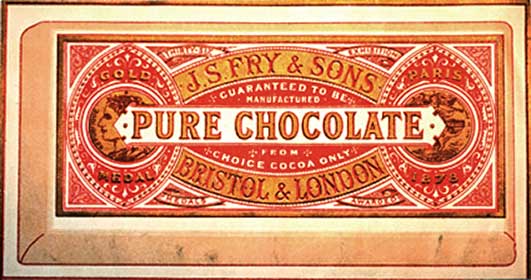
Contents
Chocolate in Soapmaking—Why?
Kinds of Chocolate for Soapmaking
Cocoa Butter as a Soapmaking Fat
Using Chocolate Products in Soapmaking
Do Chocolate Scent and Color Survive?
Dark Chocolate Soap
Cocoa Butter Soap
Chocolate Coconut Soap
Chocolate-ish Soap
Chocolate Scents
Vanilla and Discoloring
What Would I Do?
Resizing a Soap Recipe
Soaps from the Past—Marseille Soap
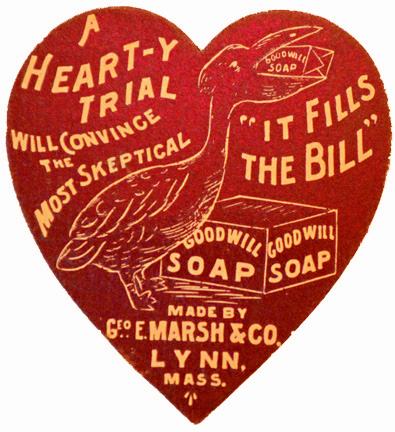
Chocolate in Soapmaking—Why?
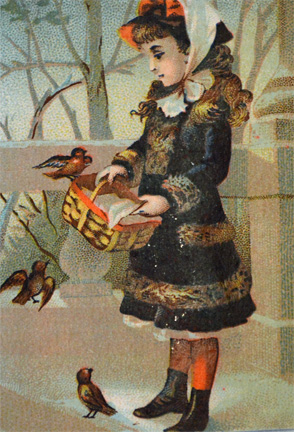
Trade Card for Lautz Bros. Soap
Other than personal preference, the reason for making chocolate soap would be mostly marketability. It would probably be a seasonal or gift-type product, and it seems to sell better in some markets than in others.
Variations on chocolate soap—such as chocolate mint, chocolate cherry, or chocolate orange—may be especially attractive. It's important for the soaps to have a strong chocolate scent—customers will sniff before they buy. Guest soap sizes of chocolate soap may be marketable as a novelty item, as they look very much like chocolate candy.
One caveat: Chocolate products in soap may create brown drips or residue in the shower or tub. They may also make dark lather that could stain linens.
Chocolate fragrances cause strong discoloration, which may also result in a dark lather. Lather that stains can be mostly avoided by marbling chocolate soap into a lighter colored batch—but then you probably lose the chocolate scent, or most of it.
Cocoa butter soaps have a lovely, silky texture and don't have the staining problem. They do have a mild chocolate fragrance. However, cocoa butter can clog pores and contribute to acne. If this might be an issue at all, chocolate soaps are probably best used as hand soaps rather than facial soaps.
Kinds of Chocolate for Soapmaking

Valentine trade card for Laird's Bloom of Youth and White Lilac Soap
There's a wealth of chocolate products to choose from:
- baking chocolate
- cocoa powder
- chocolate chips
- white chocolate
- semi-sweet/bittersweet chocolate
- chocolate milk
- cocoa butter
And a few that it may be wise to avoid:
- candy melts
- chocolate candy
- chocolate syrup
- any product with unknown percentages of different fats
- chocolate with a higher-than-normal content of cocoa solids (such as 80% cocoa)
Cocoa Butter as a Soapmaking Fat
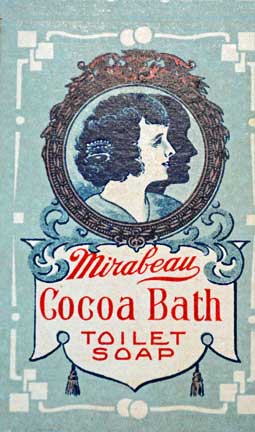
The fat in chocolate is cocoa butter, which makes a smooth, hard soap with good creamy lather. Of course, cocoa butter soap doesn't have to look or smell like chocolate. Cocoa butter is available in a deodorized form, if the chocolate scent isn't wanted. It is pale colored, so it doesn't make a soap with dark lather.
Expensive if bought in small quantities, cocoa butter is sold by soapmaking supply vendors for reasonable prices.
There is a myth that cocoa butter can only be used for a small percentage of a soap formulation. That's what it is, nothing but a myth—as long as your hardness and lather numbers work out, there's no reason not to use larger amounts.
To increase the chocolate character without affecting the lather, you could add cocoa powder, first sifting it and then stick blending it thoroughly with one of the oils. Add at trace. I'd use about one teaspoon of cocoa to each pound of base oils.
You could also mix chocolate fragrance with a little of the soap batter and swirl it in. Since chocolate fragrance will not color the soap immediately, you would probably get a better swirl if you use colorant as well.
Using Chocolate Products in Soapmaking
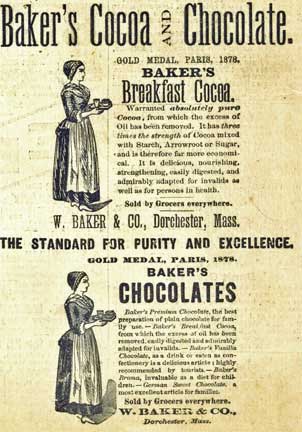
1884 ad for Baker's Cocoa and Chocolate
Since I have access to ingredients only in the United States, my calculations are based on US food labeling and ingredients laws.
There is plenty of information on food labels, but be careful of column headings when you use food labels. The "nutrition information" can be somewhat confusing, with fat percentages expressed in terms of daily average recommended dietary amounts instead of being a percentage of product weight.
Most soapmakers use cocoa or unsweetened baking chocolate for soapmaking. Other possible forms of chocolate are white chocolate, bittersweet chocolate, chocolate milk, and chocolate chips.
Many soapmakers treat the chocolate as an additive and don't figure it in the lye calculation. Typically, chocolate will be added to some of the soap batter at trace and mixed into the rest of the soap just before pouring. This works, especially if the superfatting of the formulation is low enough to absorb the extra fat. If I were going to ignore the fat in chocolate products, I'd limit superfatting to 5%. You can use a higher percentage of chocolate if you do calculate the cocoa butter as part of the fats.
Some soapmakers swirl melted chocolate into the soap at trace, but I did not try this.
If you want to calculate the chocolate as part of the fats, begin by looking at the ingredient label. It really isn't possible to do a calculation if there is a mixture of fats in the product, although I'd ignore minor amounts of milk fat. But, unless another fat is specified, the fat in the product is cocoa butter.
Unsweetened Chocolate Products
Baking Chocolate
Bitter chocolate should be around 50% cocoa butter. The rest is cocoa solids.
Use like any other solid fat. Calculate it as cocoa butter, but use double the amount of chocolate.
When melting baking chocolate, be aware that it can melt almost completely without losing its solid shape. Don't overheat.
Or superfat the soap at no more than 5% and ignore the cocoa butter in the chocolate in your lye calculation. This works fine as long as the chocolate quantity is a fairly small percentage of the soap ingredients.
Cocoa Powder
The cocoa butter content varies with brand, as do other ingredients. With US labeling, the ingredient label will list the number of grams of fat in 1 tablespoon of cocoa powder. One tablespoon of cocoa powder weighs about 7.4 grams. So if there's .5 grams of fat in 1 tablespoon of cocoa powder, as there is in one popular brand, it's about 1/15 fat. This is probably negligible. Some brands will contain 20% fat, and that might be worth calculating.
There are two types of cocoa powder—natural and Dutch process. The natural type is more acidic. This affects baking, but probably doesn't make enough difference to matter in soapmaking.
Always sift cocoa before using, and mix it carefully with the other ingredients—it has a tendency to lump. Cocoa is usually used at the rate of one teaspoon of cocoa per pound of oils.
There are several ways to mix cocoa into the soap. You can dissolve the cocoa in your liquid ingredient before making soap. It's necessary to dissolve cocoa in hot liquid, but it would have to be cooled or frozen before adding the lye.
Or withhold part of the water from the lye solution, dissolve the cocoa powder in that part of the liquid, and add at trace.
Or add the powder directly to the liquid fats, or to the soap mixture at trace. This could result in a scrub soap with gritty bits of cocoa in it. When I did it this way, it didn't produce a scrub soap, but I haven't experimented enough to say for sure that it never would. It might depend on the amount of cocoa you used.
Sweetened Chocolate Products
Sugar in a soap formulation will increase lather. It has to be handled carefully to prevent overheating and discoloration/scorching. It can also decrease time to trace. So I use Cool Technique with these products. (That's explained in my books Milk Soapmaking and Cool Soapmaking.)
Chocolate chips, white chocolate, semi-sweet/bittersweet chocolate, and chocolate milk have varying amounts of sugar. If you figure the cocoa butter in the lye calculation, use the same method as for unsweetened chocolate. Melt solid chocolate products with the solid fats.
Chocolate Chips
These are around 40% cocoa butter. If you're using the fat content in your lye calculation, make sure the product contains no fat other than cocoa butter. Also, be aware of sugar content. It varies by brand, but a tablespoon of chocolate chips contains about 8 grams, or approximately 2 teaspoons, of sugar. This would be as much sugar as would be recommended for a two pound batch of soap, and it isn't a lot of chocolate. Check the ingredients list for any "wild card" ingredients that might affect soapmaking.
White Chocolate
In the US, this will contain at least 20% cocoa butter, as much as 55% sugar, milk solids, and some salt. Check the label for sugar content. Since the recommended amount of sugar in cold process soap is no more than 1 teaspoon (.147 ounce, or 4.2 grams) per pound of oils, you can get excess sugar in your soap fairly quickly with white chocolate, which can cause it to overheat.
Semi-Sweet and Bittersweet Chocolate
This will vary by brand. Check the sugar content, and also the cocoa solids. Baking chocolate, at approximately 50% cocoa solids, causes deposits of chocolate powder on the top surface of the soap. A lower percentage would be desirable, but many gourmet semi-sweet and bittersweet chocolate products boast a higher percentage—as much as 80%. I didn't experiment with such products, but would be surprised if they made good soap.
Chocolate milk
It doesn't contain enough chocolate to calculate. Substitute chocolate milk in any milk soap recipe. Most commercial chocolate milk is skim milk, so there's no addition to creaminess in the finished soap.
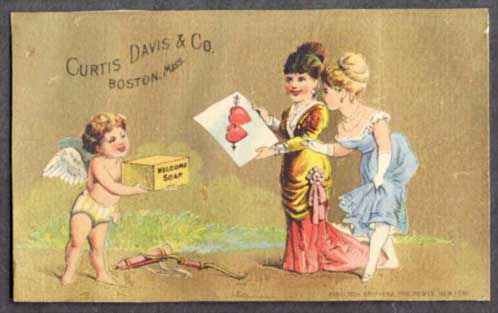
Valentine trade card from Curtis Davis & Company's Welcome Soap
Do Chocolate Scent and Color Survive?
Yes and no. In my experiments, neither the scent nor the color of some chocolate products survived saponification very well, while others remained strongly chocolate-y. But when the chocolate content is strong enough that the soap has a strong chocolate character, you're likely to get brown lather as well.
Bitter baking chocolate retains its color and a surprising amount of chocolate scent. It makes a dark lather.
Cocoa powder added to soap loses most or all of its scent. I've had batches where the color lasted, others where it didn't. Little if any color in the lather.
White chocolate and commercial chocolate milk almost disappear into soap.
Non-deodorized cocoa butter retains a chocolate fragrance. How well that comes through in soap depends on the percentage of cocoa butter, as well as any other oil odors in the blend.
Some soapmakers add chocolate to melt and pour soap. I haven't tried this, but the usual approach seems to be to add up to 1 tablespoon of cocoa powder per pound of soap base—often a cocoa butter soap base.
Dark Chocolate Soap
9 ounces (256 grams) baking chocolate
15 ounces (425 grams) coconut oil
10.5 ounces (298 grams) grapeseed oil
9 ounces (256 grams) water
4.4 ounces (127 grams) lye
1.2 ounces (34 grams) chocolate fragrance oil (optional)
I used unsweetened baking chocolate as one of the primary fats in the soap calculation. I didn't use any fragrance or added color.
The mixture produced more fumes than most, about the same as milk soap. In the Milk Chocolate Variation (below), I used Cool Technique, and the fumes were then much less.
The soap traced fairly quickly, though not accelerated. It set very quickly. A light dusting of cocoa solids rose to the top of the molds as the soap set. If desired, this could be removed in a manner similar to removing soda ash. Actually, the "frosting" is very attractive, much like the cocoa dusting on a chocolate truffle, but it's easily damaged as the soaps are unmolded.
The finished soap had a strong natural chocolate scent. The lather was brown.
I was very impressed with the way my hands felt after washing with this soap—soft and smooth. Almost like I'd used lotion.
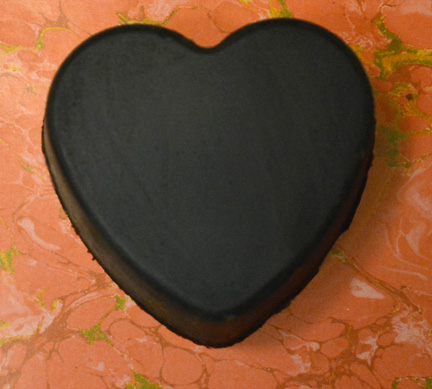
Cocoa Butter Variation—You might substitute half the quantity of cocoa butter for the baking chocolate (4.5 ounces or 128 grams). This would make a light-colored soap, unless a discoloring fragrance oil is used.
Milk Chocolate Variation—Since milk chocolate varies so much by brand, I constructed "milk chocolate" from known ingredients. I substituted half and half (light cream) for the water and added 1½ teaspoons of sugar. Because of the cream and sugar, I used Cool Technique. The soap traced quickly. I'd hoped the cream would make it lighter-colored, like a chocolate candy bar, but it didn't. It was as dark as the Dark Chocolate Soap. Further experiments in lightening the color by replacing some of the chocolate with cocoa butter or by adding titanium dioxide would be possible.
Cocoa Butter Soap
If you use cocoa butter that hasn't been deodorized, you get a good chocolate scent. I recommend making this one in tray or individual molds. Cocoa butter, like milk products, can overheat, resulting in bull's-eye discoloration. Consider chilling molds for an hour or so after pouring.
7.5 ounces (213 grams) almond oil
9 ounces (255 grams) cocoa butter
13.5 ounces (383 grams) coconut oil
9 ounces (255 grams) water
4.5 ounces (128 grams) lye
Optional: 1.2 ounces (34 grams) chocolate fragrance oil
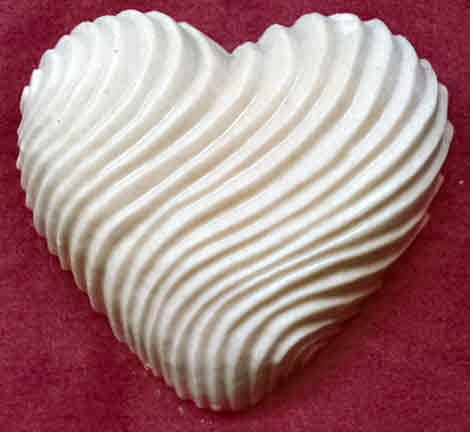
White Chocolate Variation—Commercial white chocolate contains too much sugar and too little cocoa butter to be ideal for soapmaking. Using the same approach as with milk chocolate, I modified the cocoa butter soap recipe by using half and half (light cream) for the liquid, adding 1½ teaspoons sugar before freezing it. White chocolate fragrance oil is available, and would add to the interest of this soap.
Chocolate Coconut Soap
I must admit, I fell in love with coconut oil soap after trying it for my January entry. Here's a chocolate version.
30 ounces (851 grams) coconut oil
9 ounces (255 grams) commercial or homemade chocolate milk, frozen
4.4 ounces (125 grams) lye
Use Cool Technique. This soap won't have noticeable chocolate scent, unless you use a chocolate fragrance.
I made this with homemade chocolate milk (added 1 teaspoon natural cocoa and 1 teaspoon sugar to the milk and blended well before freezing). The color was darker than chocolate milk soap I've made with commercial chocolate milk.
Time to trace was unusually long, and the fumes were unusually pungent, even with the frozen liquid. Make sure you have excellent ventilation when you make this one.
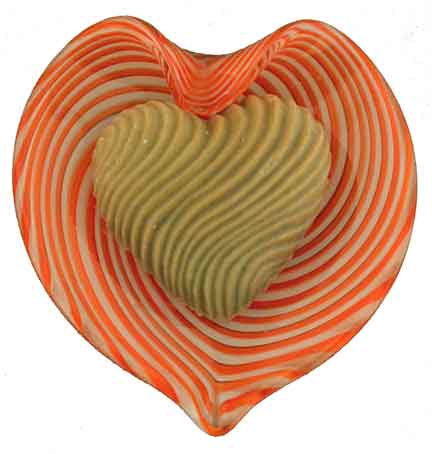
Chocolate-ish Soap
The only chocolate in this one is the fragrance. Expect fairly quick trace.
This is a "leftovers" soap. You can combine whatever oils you have in the cupboard, even if there's not much, to make fine soap. Just check the lather and other values on SoapCalc to make sure you'll like it.
1.5 ounces (43 grams) castor oil
9 ounces (255 grams) grapeseed oil
1.5 ounces (43 grams) refined wheat germ oil
3 ounces (85 grams) hemp butter
9 ounces (255 grams) coconut oil
3 ounces (85 grams) avocado butter
2 ounces (57 grams) chocolate fragrance, or as recommended by vendor
9 ounces (255 grams) water
4.1 ounces (118 grams) lye
The "dark chocolate" fragrance oil I used in this soap did have a rich chocolate scent in the bottle. However, the finished soap did not actually smell much like chocolate, compared to the real thing. In fact, the vanilla character of the fragrance came through more strongly than the chocolate. Different vendors' fragrances will vary, but this one was far from impressive as a chocolate scent.

Chocolate Scents
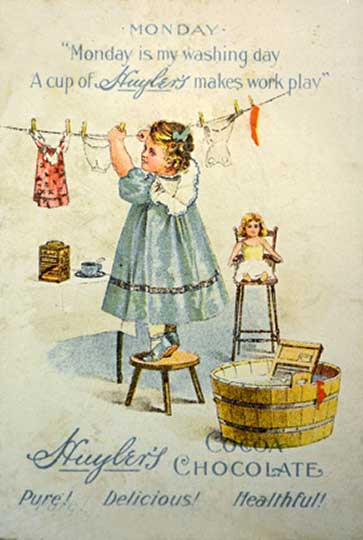
Chocolate essential oils and absolutes are available but expensive. They do survive saponification to a degree but may fade. This is one scent I'd definitely add at trace, to minimize the effect of the lye.
Most soapmaking vendors sell only chocolate fragrance oils, rather than the natural product. These fragrances may be a pure chocolate scent, or may be mixed with mint, coffee, almond, or other fragrances. All the ones I checked were discoloring fragrances—they turned the soap brown. That's an advantage in the case of chocolate soap—unless it also makes brown lather. If you're not sure, ask the vendor what to expect.
But just as with natural chocolate color, the lather will probably be dark if the soap is dark.
Vanilla and Discoloring
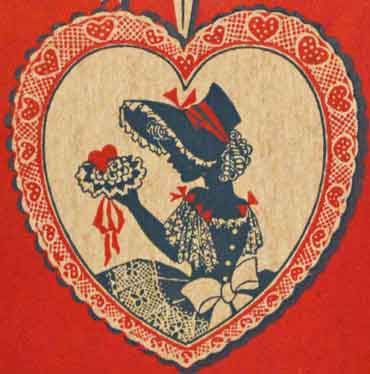
Fragrances that contain vanilla—as chocolate fragrances often do—will discolor cold process soap to various shades of tan or brown, depending on how much vanilla is in the fragrance. And many more fragrances contain vanilla than you might think at first.
Food scents are very likely to contain it—even some of the fruit fragrances. Rich, spicy fragrances like frankincense or dragon's blood may also contain enough vanilla to discolor. You have to rely on your vendor for this information. It should be posted with the fragrance information, but if it isn't, ask.
Vanilla stabilizer exists, but it's only recommended for melt and pour soap. It may work temporarily in cold process soap.
The color change happens from the outside in. If you were to cut a bar of soap in half a few days after pouring it into the mold, it wouldn't have turned brown in the middle. It would look like a chocolate-covered candy. Eventually, the whole soap will discolor.
A non-discoloring vanilla fragrance is available, but most soapmakers agree that its scent isn't as true as the best of the discoloring vanillas. None of the vanilla-containing fragrance blends seem to feature it.
What Would I Do?

If I were making soap to sell, I'd be very experimental with chocolate soaps. I've heard over and over that they just don't sell in some markets.
I'd be just as slow to market any soap that had dark lather. You may get customer complaints if the soap creates a mess in the tub or shower, or if it stains pale towels.
I'd definitely make cocoa butter soap again. It has a lovely silky texture, and the pale color would make it good for use with natural colorants.
Resizing a Soap Recipe

Do you really need to recalculate when you resize?
The standard advice for resizing a recipe is to recalculate the lye and liquid. Supposedly, the increase or decrease in the amounts of those ingredients may not be exactly a factor of the increase or decrease in the recipe. I say it myself in my books.
I have to admit, I got caught in a soapmaking myth. To some extent, anyway.
Numerous calculations have verified what some readers have told me—if you double the oils in a soap recipe, the lye and liquid amounts come out double when you recalculate. Or whatever multiple you use, whether it's doubling, halving, or multiplying by ten, the lye and liquid amounts won't increase or decrease unpredictably.
However, it's always a good idea to check a recipe. Especially if you haven't made it before, it's necessary to check. I get questions and cries for help regularly from people who've unsuspectingly made a bad recipe they got online, or even from a book.
Also, if you're a beginner, please don't rush into big batches too soon. They truly are a bit harder to handle—not seriously difficult, but not as easy as a small batch. Get a little experience under your belt first, and be careful to mix thoroughly—you can get uneven trace in a big pot of soap if you don't.
Soaps from the Past—Marseille Soap
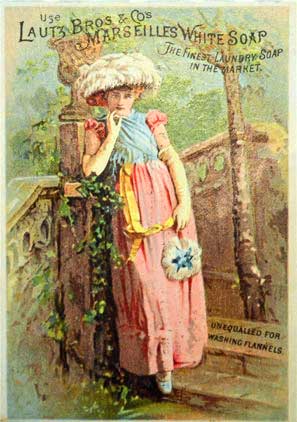
Trade card for Lautz Bros. Marseilles White Soap
Marseille soap is "soap from the past" in one sense: It was legally defined by Louis XIV in 1688 in the Edict of Colbert. It is produced by a hot process that takes approximately two weeks, and involves large vats of salt water—originally water from the Mediterranean Sea.
In another sense, it is not "past," because it is still made. It is absolutely excellent soap. The lather is much better than the lather of any cold process 100% olive oil soap I've made or tried.
Originally restricted to 100% olive oil, Marseille soap was made fairly early in a version called "Marseille white soap," using a combination of palm and coconut oils.
The traditional shape, curiously, is a cube.
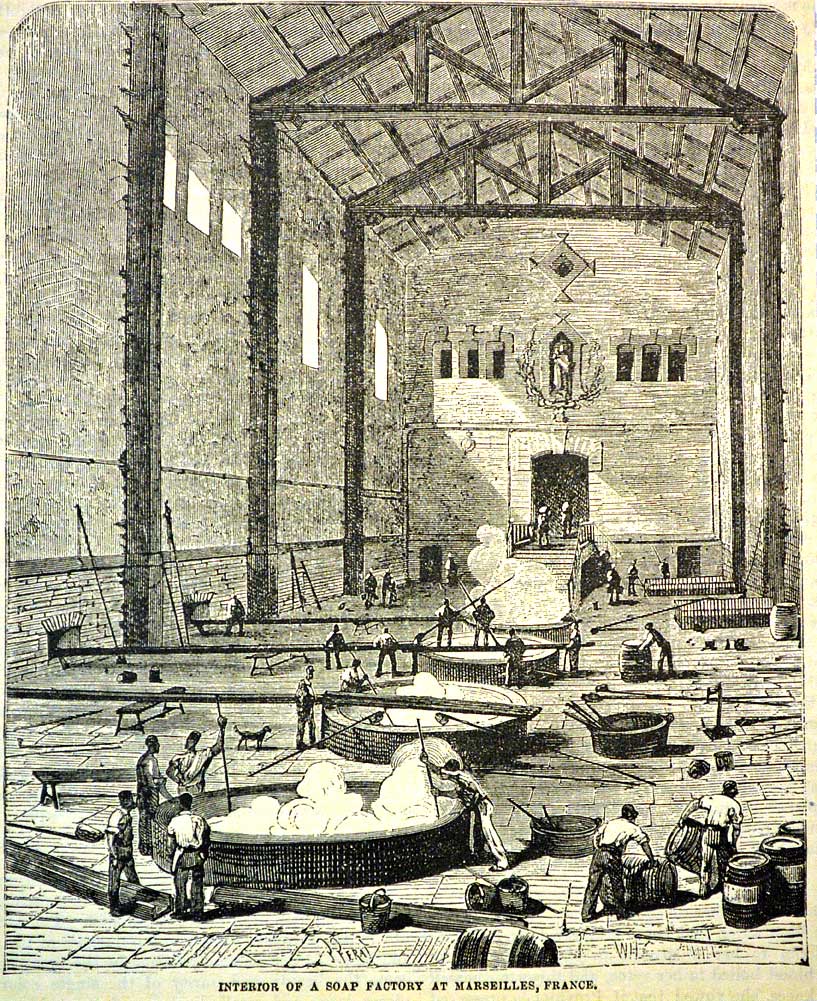
Nineteenth-century Marseille soap factory





